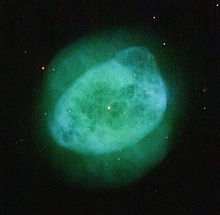IC 289
This article needs additional citations for verification. (April 2017) |
| Emission nebula | |
|---|---|
| Planetary nebula | |
 As seen by Hubble | |
| Observation data: J2000.0 epoch | |
| Right ascension | 03h 10m 19.3017s[1] |
| Declination | +61° 19′ 00.914″[1] |
| Distance | 5,190 ± 500 ly (1,592 ± 153 pc)[2] ly |
| Constellation | Cassiopeia |
| Designations | IRAS 03062+6107, 2MASS J03101930+6119009, ARO 86, Hb 1, VV 9, RL 67, Lan 496, NSV 1056, GSC2 N313033135782[1] |
IC 289 is a planetary nebula in the constellation Cassiopeia.[3] It was discovered by Lewis Swift in early September 1888. It lies close to the 10th magnitude star BD +60° 0631. N.J. Martin described IC 289 as "A nice, faint round planet like planetary nebula. The uniform oval disc shows some irregularity in brightness but is not obviously brighter at the edge."[citation needed]
References[]
- ^ Jump up to: a b c "IC 289". SIMBAD. Centre de données astronomiques de Strasbourg. Retrieved 2020-02-18.
- ^ Brown, A. G. A.; et al. (Gaia collaboration) (August 2018). "Gaia Data Release 2: Summary of the contents and survey properties". Astronomy & Astrophysics. 616. A1. arXiv:1804.09365. Bibcode:2018A&A...616A...1G. doi:10.1051/0004-6361/201833051.
- ^ IC 289
External links[]
 Media related to IC 289 at Wikimedia Commons
Media related to IC 289 at Wikimedia Commons- http://www.noao.edu/outreach/aop/observers/ic289.html
Categories:
- Planetary nebulae
- IC objects
- Cassiopeia (constellation)
- Nebula stubs